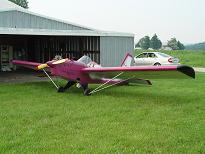
By (USUA #A86096)

|
| "Plum Krazee" (Large View) |
We hear from the Shenandoah Flyers of Greenwich, Ohio that the Galion Aviation and Education Day is scheduled for Saturday 8 September, featuring a breakfast and lunch menu. Highlights of the day will include Young Eagles flights and aerobatic demonstrations and rides in Butch Fisher's EZ300 (a chance to get rid of that breakfast or lunch?) Those of you within flying distance of Galion Municipal Airport (KGQQ) might like to drop in for some food and fun with the folks of Club 603.
While I am on the subject, I'd like to take the opportunity to do a little "housekeeping" here. Those of you who sponsor events as fund raisers, educational events, to publicize the sport of flying, or to just have a good time, might consider advertising your event on USUA's calendar of events. A word of caution - be sure to fill out the complete form (which is actually in two parts. Part one gives an opportunity to describe the event, and Part two asks you to provide such important information as the date and time of the event. This year, a number of folks have posted descriptions of interesting events but failed to provide info as to where, and when. This leaves us with no alternative but to reject the submission, as there is no way that we can determine who submitted the info so we can ask them for this vital information.
The Terre Haute Ultralight Club's newsletter for July tells us that their sixth annual competition was scheduled for July 21st. We received this information too late to publicize it for them but would certainly like to hear about the results of their competition.
This newsletter also reported on an off-airfield landing due to engine failure. They provided some details that can serve as a reminder to all of us which I will quote here.
"{The pilot} was forced to make an emergency powered parachute landing southwest of KeeDot {air port) when the Rotax 503 began cutting out. (The pilot) had noticed an abnormally high CHT and EGT reading of 1200+ on one cylinder and discussed the problem by radio with my son, Brad, who was flying another unit.
"They decided to get the plane down as soon as possible and found a level piece of sand near the river levee where a normal landing was made.
"I took the engine to Mark Smith who took the heads and cylinders off and found the bottom ring of both pistons stuck, one so tight that it could only be removed in pieces. Both pistons were darkened more than half way down on the sides indicating considerable blow-by and probable cause of engine cutout and high EGT and CHT.
"Mark said that when pistons are brown or black below the rings, which can be seen through the exhaust ports, it is an indication of sticking rings and time for an engine tear down, cleaning and possible overhaul.
"I guess the moral of this story is watch for good landing places, high EGT and CHT during flights and darkened pistons and stuck rings during regular engine inspections."
The author, Alan Neal, is very happy that his daughter considers this incident "just part of the fun of flying". However, it can serve as a reminder to all of us that maintenance of equipment is an important part of flying safely. We are all glad that Alan's daughter, Ann, was able to land safely and was aware enough to notice that an emergency landing was called for in this instance. Her skills allowed her to land safely and suffer no more than a prolonged fight with the mosquitoes near the river as she awaited the arrival of her brother and the recovery vehicle.
That's it for another month, Ultralighters. Fly safe and have fun.